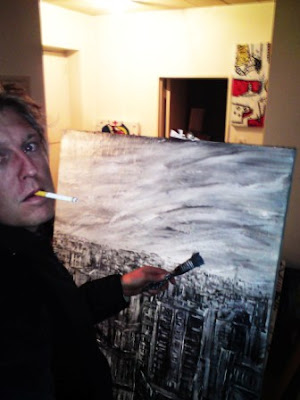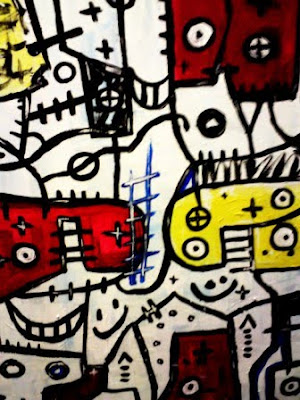The Superstroke Art Movement was formed as a reaction to the influence that The Superflat Art Movement has on contemporary art. Superstroke still regards Superflat as the most avant-garde and most important 21st century art movement in the world at the moment. According to ourselves The Superstroke Art Movement is the second most avant-garde (after Superflat), most expressive 21st century art movement in the world at the moment. Therefore it is important to understand Superflat when confronted with an art work from The Superstroke Art Movement.
According to Wikipedia, Superflat can be described as follows: Superflat is a postmodern art movement, founded by the artist Takashi Murakami, which is influenced by manga and anime. It is also the name of a 2001 art exhibition, curated by Murakami, that toured West Hollywood, Minneapolis and Seattle.
"Superflat" is used by Murakami to refer to various flattened forms in Japanese graphic art, animation, pop culture and fine arts, as well as the "shallow emptiness of Japanese consumer culture." A self-proclaimed art movement, it was a successful piece of niche marketing, a branded art phenomenon designed for Western audiences. Superflat has been embraced by American artist creating a hybrid called “SoFlo Superflat”.
Artists whose work is regarded as “Superflat” include Chiho Aoshima, Mahomi Kunikata, Sayuri Michima, Yoshitomo Nara, Tatsuyuki Tanaka, Aya Takano and Takashi Murakami. In addition, some animators within anime and some manga artist are considered Superflat, especially Koji Morimoto, and the work of Hitoshi Tomizawa, author of Alien 9 and Milk Closet.
Murakami defines Superflat in broad terms, so the subject matter is very diverse. Often the works explore the consumerism and sexual fetishism that is prevalent in post-war Japanese culture. This often includes lolicon art, which is parodied by works such as those by Henmaru Machino. These works are an exploration of otaku sexuality through grotesque and/or distorted images. Other works are more concerned with a fear of growing up. For example, Yoshitomo Nara’s work often features playful graffiti on old Japanese ukiyo-e executed in a childish manner. And some works focus on the structure and underlying desires that comprise otaku and overall post-war Japanese culture.
Murakami is influenced by directors such as Hideaki Anno.
One of the artists from The Superflat Art Movement that has quite a large influence on The Superstroke Art Movement is Yoshitomo Nara. The art of Yoshitomo Nara can be described as follows: Nara first came to the fore of the art world during Japan’s Pop art movement in the 1990s. The subject matter of his sculptures and paintings is deceptively simple: most works depict one seemingly innocuous subject (often pastel-hued children and animals drawn with confident, cartoonish lines) with little or no background. But these children, who appear at first to be cute and even vulnerable, sometimes brandish weapons like knives and saws.
Their wide eyes often hold accusatory looks that could be sleepy-eyed irritation at being awoken from a nap—or that could be undiluted expressions of hate.
Nara, however, does not see his weapon-wielding subjects as aggressors. "Look at them, they [the weapons] are so small, like toys. Do you think they could fight with those?" he says. "I don’t think so. Rather, I kind of see the children among other, bigger, bad people all around them, who are holding bigger knives…"
Lauded by art critics , Nara’s bizarrely intriguing works have gained him a cult following around the world and the respect from other artists from The Superflat Art Movement.
The Super Flat Art Movement Manifesto written by Takashi Murakami is as follows:
The world of the future might be like Japan is today -- super flat.
Society, customs, art, culture: all are extremely two-dimensional. It is particularily apparent in the arts that this sensibility has been flowing steadily beneath the surface of Japanese history. Today, the sensibility is most present in Japanese games and anime, which have become powerful parts of world culture. One way to imagine super flatness is to think of the moment when, in creating a desktop graphic for your computer, you merge a number of distinct layers into one. Though it is not a terribly clear example, the feeling I get is a sense of reality that is very nearly a physical sensation. The reason that I have lined up both the high and the low of Japanese art in this book is to convey this feeling. I would like you, the reader, to experience the moment when the layers of Japanese culture, such as pop, erotic pop, otaku, and H.I.S.ism, fuse into one. [H.I.S. is a discount ticket agency in Japan. By lowering the price of travel abroad, the company is having a profound effect on the relationship between Japan and the West.]
The manifesto written for The Superstroke Art Movement by Conrad Bo in 2008 is as follows:
1. Paintings and sculptures should be executed using expressive even violent brushstrokes on at least some part of the picture or surface.
2. Should a photograph be used for a figurative painting, the objection should not be Photorealism, but Expressionism.
3. If mediums such as pen, pencil, etc are used, the pen and pencil strokes must at least be overly expressive for it to be considered a Superstroke picture.
4. Paintings can be executed in both the abstract and figurative.
5. Subject matters such as Africa, light, dark, life and death are encouraged.
6. Collage, Stencil and Calligraphy may be used for impact.
7. The concept, Art for the sake of art, does not apply in Superstroke. In Superstroke it is art for the sake of Superstroke, as the artist must always strive for paintings rich in texture, or excessive brush or pencil strokes.
Here are some photos from The Superstroke Art Movement.



























.JPG)
.JPG)
.jpg)
.JPG)
.jpg)
.JPG)
.JPG)
.JPG)
















